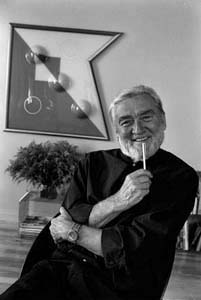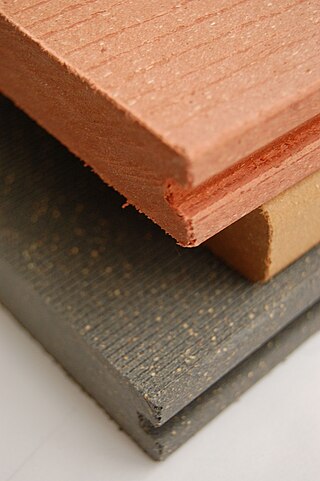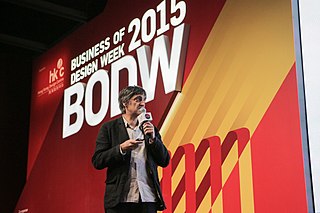
Philippe Starck is a French industrial architect and designer known for his wide range of designs, including interior design, architecture, household objects, furniture, boats and other vehicles.

Verner Panton is considered one of Denmark's most influential 20th-century furniture and interior designers. During his career, he created innovative and futuristic designs in a variety of materials, especially plastics, and in vibrant and exotic colors. His style was very "1960s" but regained popularity at the end of the 20th century. As of 2004, Panton's best-known furniture models are still in production.

Wood–plastic composites (WPCs) are composite materials made of wood fiber/wood flour and thermoplastic(s) such as polythene (PE), polypropylene (PP), polyvinyl chloride (PVC), or polylactic acid (PLA).

Jasper Morrison is an English product and furniture designer. He is known for the refinement and apparent simplicity of his designs. In a rare interview with the designer, he is quoted as saying: "Objects should never shout."

Modern furniture refers to furniture produced from the late 19th century through the present that is influenced by modernism. Post-World War II ideals of cutting excess, commodification, and practicality of materials in design heavily influenced the aesthetic of the furniture. It was a tremendous departure from all furniture design that had gone before it. There was an opposition to the decorative arts, which included Art Nouveau, Neoclassical, and Victorian styles. Dark or gilded carved wood and richly patterned fabrics gave way to the glittering simplicity and geometry of polished metal. The forms of furniture evolved from visually heavy to visually light. This shift from decorative to minimalist principles of design can be attributed to the introduction of new technology, changes in philosophy, and the influences of the principles of architecture. As Philip Johnson, the founder of the Department of Architecture and Design at the Museum of Modern Art articulates:
"Today industrial design is functionally motivated and follows the same principles as modern architecture: machine-like simplicity, smoothness of surface, avoidance of ornament ... It is perhaps the most fundamental contrast between the two periods of design that in 1900 the Decorative Arts possessed ..."

Vitra is a Swiss family-owned furniture company with headquarters in Birsfelden, Switzerland. It is the manufacturer of the works of many furniture designers. Vitra is also known for the works of notable architects that make up its premises in Weil am Rhein, Germany, in particular the Vitra Design Museum.

Alexander Girard, affectionately known as Sandro, was an architect, interior designer, furniture designer, industrial designer, and a textile designer.

Barber Osgerby is a London-based industrial design studio founded in 1996 by British designers Edward Barber and Jay Osgerby. Historically named variously Barber Osgerby Associates, BOA, Barber & Osgerby and BarberOsgerby, the practice has been called Barber Osgerby since 2008. Barber and Osgerby's work encompasses interiors, furniture, lighting and product design as well as art and architectural-scale projects.
Alberto Meda is an Italian engineer and designer. His work is held in museums around the world. He works and lives in Milan.

Martí Guixé is a Spanish designer living in Barcelona and Berlin. He graduated in interior design from Elisava in Barcelona in 1985 and enrolled in an industrial design study program in Scuola Politecnica di Design di Milano in 1986. In 2001, as a statement against the limited scope of the traditional designer and to open new possibilities for the industry Guixé started an ex-designer movement, defining himself by the same name.

A bean bag is a sealed bag containing dried beans, PVC pellets, expanded polystyrene, or expanded polypropylene. The bags are commonly used for throwing games, but they have various other applications.

The polypropylene stacking chair or polyprop is a chair manufactured in an injection moulding process using polypropylene. It was designed by Robin Day in 1963 for S. Hille & Co. It is now so iconic, it was selected as one of eight designs in a 2009 series of British stamps of "British Design Classics".
Ronan & Erwan Bouroullec are brothers noted for their design work, which has been featured in publications and museums globally — and spans a wide range from tables and chairs to tableware, rugs, textile walls, office furniture, ceramics, art objects and urban projects.

The Bofinger Chair, also named BA 1171, was designed by architect and designer Helmut Bätzner in 1964. In close co-operation with Bofinger company, situated in Ilsfeld in Baden-Württemberg/Germany, under owner and managing director Rudolf Baresel-Bofinger, the Bofinger stacking chair was developed into the first one-piece plastic chair worldwide in fibreglass- reinforced polyester to be mass-produced in one single pressing process over a steel mould. The material was dyed all way through before being processed and available in a range of colours including white, yellow, black, red, blue, green, brown and orange. In a long trial series the characteristic shape of the chair was found in regard to seating shape, maximum stability by smallest quantity of material used, required elasticity, stacking capability, and industrial mass-production. The pressing process in the heated steel mould with a weight of approximately 11 tons lasted under five minutes and required as finishing treatment only simple scraping round the edges to remove excess polyester.

The Panton Chair is an S-shaped plastic chair created by the Danish designer Verner Panton in the 1960s. The world's first moulded plastic chair, it is considered to be one of the masterpieces of Danish design. The chair was included in the 2006 Danish Culture Canon.

Hille ( HIL-ee} is a British Modern furniture manufacturer which is especially noted for its range of Modernist chairs. Its products have been influential in the history of interior design and the company has been engaged internationally in a number of major design projects, including furnishings for the Royal Festival Hall and Gatwick Airport. A number of prominent furniture designers have worked for Hille, including Robin Day and Fred Scott.

The Eames Molded Plastic & Fiberglass Armchair is a fiberglass chair, designed by Charles and Ray Eames, that appeared on the market in 1950. The chair was intentionally designed for the International Competition for Low-Cost Furniture Design. This competition, sponsored by the Museum of Modern Art, was motivated by the urgent need in the post-war period for low-cost housing and furnishing designs adaptable to small housing units.

Emeco is a privately held company based in Hanover, Pennsylvania. The Emeco 1006, known as the Navy Chair, has been in continuous production since the 1940s. Today, Emeco manufactures furniture designed by notable designers and architects such as Philippe Starck, Norman Foster, and Frank Gehry.

Konstantin Grcic, born 1965, is a German industrial designer known for his design of furniture and household products, some of which have been featured in design shows and museums. His design language is characterized by the use of geometric shapes and unexpected angles.
Covema srl was a historic Italian company specializing in the design of plastic processing machinery, based in Milan, via Fontana 1. Founded in 1953 by the Terragni brothers, it also included the companies Corima spa, GBF spa, GBF iberica, RIAP srl, FIRS spa, Covepla Spain, Italproducts srl, Omam spa, TPA srl, AGRIPAK srl, Floraplant srl, Interfinance SA, Technical Die spa, Covema SAE. The technology that Covema has developed since the 1950s is merged into Agripak srl based in Milano and managed by the sons of Marco Terragni: Fabio Terragni (president), Patrizia Terragni and Massimo Terragni.





















